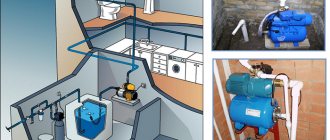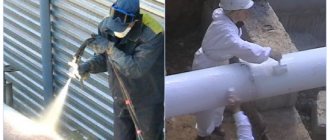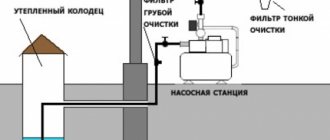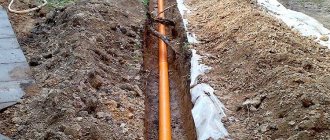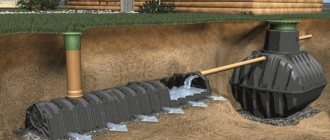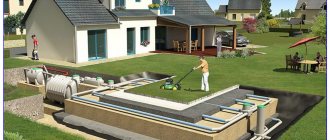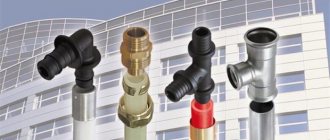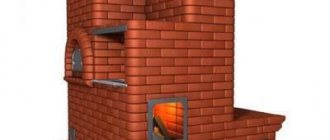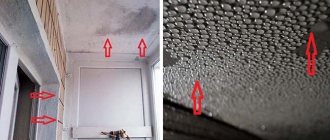Here you will learn:
- How to develop a plumbing diagram
- External (external) water supply
- Internal water supply
- Step-by-step work algorithm
- Pipe layout: collector or series
- Laying methods - hidden and open system
- Main components of the circuit
- Pipe selection
- Operating principles and useful tips
- Common installation mistakes
Water supply wiring in a private house is carried out in two ways - collector and sequential connection schemes. You can lay pipes in a hidden or open way.
How to develop a plumbing diagram
In order for everything to work out correctly in the end, before installing the water supply it is necessary to carefully work out the layout of its installation on the street and its wiring in the cottage. If this project is done correctly, it will avoid many problems during installation work and subsequent operation of the assembled water supply system.
Water supply scheme for a private house
When developing such a water supply scheme, the following is calculated:
- number of water supply points in the house;
- the need and number of collectors;
- pump power and water heater capacity;
- pipe sizes;
- characteristics of shut-off valves.
Plus, you select the option of pipe routing (collector or sequential) and the placement of all elements of the water supply system in a private house. At first glance, it is easier to install the same electrical wiring in an apartment or a ventilation system. However, both have their own nuances. And even with the slightest mistakes, there will be many problems in all cases.
External (external) water supply
There are three options, depending on the source of water intake.
- If the country water supply is connected to the central one. Why is the connection point determined, and then the pipework goes underground to the house. The main requirement for this scheme is the straightness of the pipe laying in order to reduce the cost of purchasing it, the second is the insulation of the wiring by laying the pipes in insulating cylinders made of foam-type polymer materials. Although you can use any other insulation.
- Well. The simplest option for organizing water supply for a private home. A well up to 10 m deep is dug by hand, its trunk is formed, into which the pump is lowered. And a pipe is stretched from it to the house, this is done in exactly the same way as in the case of connecting to the central village water supply.
- Well. Everything is the same as with the well. However, it should be noted that water from a well is a liquid of high quality and purity, and in the required volumes. One well can even provide water to several private houses.
Water supply from a well or borehole
Attention! The central water supply does not always provide homes with water at the required pressure. But it will always operate, even if there is a power outage in the village. Unfortunately, the pumps immediately turn off. True, this problem can be solved by installing a storage tank or hydraulic accumulator in the water supply pipes of a private house.
There are several interesting points regarding the ability to avoid high costs by installing an external plumbing system. Firstly, both a well and a well can be built inside the house. This will have to be done before construction of the building begins. Thus, the external water supply becomes an internal one. This means that there is an opportunity to save a lot on laying pipes along the street.
The second concerns the well. You can install a caisson on top of its barrel, which will accommodate a pump, a hydraulic accumulator, an automation unit, some filter elements, and several gate valves. That is, the external part of the water supply network may be difficult in terms of increasing the equipment installed in it.
Well caisson
No. 6. Polypropylene pipes
Polypropylene pipes are actually an ideal option for organizing water supply . Can be unreinforced or reinforced . The former are suitable only for cold water supply, the latter are used for both heating and hot water supply. The pipe can be reinforced with aluminum, fiberglass or other materials. Reinforcement increases strength and reduces thermal elongation of polypropylene. The best option is fiberglass reinforcement.
Polypropylene pipes for water supply
Today, the highest quality reinforced pipes are produced in Germany. Detailed technical characteristics and a list of objects where such pipeline systems are installed can be found on the website of the representative of the German plant aquatherm GmbH - Agpipe Group of Companies: https://agpipe.ru/plastikovie_trubi_dlya_vodoprovoda/polipropilenovie_trubi_dlya_vodosnabzheniya
Advantages of polypropylene pipes:
- durability up to 50 years;
- the ability to withstand temperatures inside pipes up to +90-950C and pressure up to 20 atmospheres (this applies to the reinforced version);
- relatively easy installation. The pipes are connected using a special welding machine for polypropylene. Working with it is not difficult; it will take a little time to learn and bring the process to automation;
- strong connections;
- such pipes will even withstand freezing of water inside them;
- corrosion resistance;
- sufficiently high strength;
- relatively low price
Among the disadvantages is the fear of high external temperatures, so this is not an option for fire hazardous areas. In addition, even when reinforced with aluminum or nylon thread, the material retains a high level of thermal deformation, so the use of insulation for hidden pipe routing, or compensators for open routing, is indispensable. If you weigh all the pros and cons, then it is better to choose polypropylene pipes for water supply at home.
Internal water supply
The complexity of distributing water around the house is related to the number of consumers (taps and mixers) and their location. Therefore, first of all, it is necessary to develop a scheme. This is the most important stage in the installation process, which should not be neglected. There is nothing difficult in drawing up a diagram. You just need to arm yourself with a tape measure and measure the distances from consumers to the connection points of each device.
Transfer all this to paper, taking into account the size and configuration of the pipes. The diagram will show exactly how many pipes and fittings will need to be used in the installation process, where deviations from straight-line wiring will occur, and where passages through load-bearing and non-load-bearing elements of the building will be installed. And the more rooms are involved in the plumbing system, the more complex the scheme will be.
One of the plumbing diagrams
Attention! In the wiring diagram, it is necessary to take into account all the elements of the water supply system: collectors, pumps, filters, tanks and shut-off valves. It must indicate the distances between elements and changes in network configuration.
Step-by-step work algorithm
How to install water in apartments? To replace the old water supply system in an apartment, you can turn to a professional and you will not have to choose the material, wiring diagram and install the system, however, such services are quite expensive. In turn, organizing water distribution in an apartment with your own hands requires careful compliance with building codes and regulations. This event is divided into several main stages:
First, experts recommend preparing a plan for future work. Such a plan should include two main points:
- choice of material. Many people are interested in one question: which pipes to choose for water supply? Pipes can be made of metal, metal-plastic or plastic. Each material has its own characteristics, which must be carefully studied so as not to encounter unexpected problems in the future. Which material is better suited for installing water pipes: polypropylene or metal-plastic? Metal-plastic pipes are most suitable for self-distributing water supply. Installing metal-plastic communications is quite simple, so even a beginner can do this work. In any case, polypropylene or metal-plastic are ideal for water pipes;
- choosing a water distribution scheme for the apartment. The installation scheme for water supply communications is determined depending on the type of multi-story building. Today, the most popular are two schemes: serial and parallel. A sequential wiring diagram is used if the water pressure in the apartment is always stable, however, this is extremely rare. Therefore, most often for the installation of a water supply structure, the second option is used, namely: parallel or collector distribution of water supply and sewerage.
The collector distribution system is a modern and more practical option; in such a water supply the pressure will be stable
Note! The main advantage of collector water distribution in an apartment is the ability to control the pressure of the working fluid in individual water intake sources.
Calculation of fittings and other auxiliary elements, as well as the pipeline cross-section. It is recommended to install shut-off valves in front of each water intake source. It is important to remember that the cross-sectional area of the pipes should be smaller than that of the connecting elements.
The fourth point of the diagram includes a list of tools necessary for wiring.
Dismantling old communications and laying new ones. When dismantling an old structure, it is very important to ensure that the cross-sectional area of all outlets and pipes is observed, otherwise you will have to use special adapter couplings.
As a rule, in standard apartments the rooms where the plumbing structures are located have a limited area. In this regard, it is recommended to give preference to the most compact option for laying a water supply. As mentioned above, pipes made of different materials can be used for water supply in an apartment.
Pipe dimensional characteristics
Water supply pipes (regardless of the material from which they are made) have common dimensional characteristics:
- inner diameter;
- outside diameter;
- Wall thickness;
- total length.
In addition to these characteristics, when choosing, you should take into account the number of turns and connections when laying the hydraulic system.
The main indicator for water pipes is the internal diameter; the pressure and flow of water at the end points of the system, in taps, internal pressure in the pipelines, and the quietness of its operation depend on it.
Pipe layout: collector or series
Regardless of which source of water supply has been selected, the optimal piping scheme for the facility is selected: sequential or collector piping of the water supply system. When designing a network, you need to pay attention to the following factors:
- the number of people living in the house;
- frequency of stay in the house;
- intensity of water use.
Tee (or sequential) pipe distribution from a heater, main or riser takes place by connecting plumbing equipment one after another. Thus, the installation of the system requires a minimum amount of materials and time, however, this connection method has two significant drawbacks:
- Uneven pressure in the system when used simultaneously by several users. That is, for example, when you turn on the water in the bathroom or kitchen, normal water pressure will only be in the tap located closer to the source.
- To repair an individual element of the system, it is necessary to completely shut off the water supply to the building.
An example of a series connection of pipes.
With a collector (or parallel) connection, pipes are supplied to the intake points directly from the distribution manifold (individual distributors are provided for hot and cold water). Collector wiring allows all users to constantly receive stable water pressure, regardless of the number of simultaneously turned on plumbing fixtures. The main disadvantage of this method is the large number of pipes, which are difficult and expensive to hide.
Manifold piping on the floor.
In recent years, combined distribution of water supply pipes has become increasingly popular, in which short lines are installed in series and later collected into a collector. This method is a budget alternative to parallel connection of pipes. After all, it requires significantly less material for installation, and in the event of a breakdown, it is enough to turn off the water supply to just one short branch.
What pipe diameter to choose for water supply in a private house
As shown above, the pipe diameter is specified by fixed values from a standardized number series with a significant variation. This makes accurate calculation using formulas, tables and online calculators a meaningless procedure in the vast majority of cases. Even the simplest option of determining the diameter based on the throughput of pipes and summing up the water consumption of simultaneously turned on plumbing equipment (Table 3.) is not worth the time spent and was carried out long ago by specialist installers.
Outside
If an individual water supply system is installed for a private house, then water from a submersible or surface electric pump enters it through an underground pipeline made of low-density polyethylene HDPE.
The outlet pipes of most pumps are designed to accept pipes with a diameter of 1 or 1 1/4 inches, that is, outer diameters of 25 and 32 mm. Since the pipeline from electric pumps is prohibited from being narrowed, installers have no choice which pipes to use.
Sometimes, if the outlet of the electric pump has a 1-inch (25 mm) outlet pipe, and the distance to the house is too great, a larger diameter 1 1/4-inch (32 mm) pipeline is used to reduce hydraulic losses.
The same applies when connecting from a centralized water main. In the vast majority of cases, installers do not face the question of which pipe to choose. It is enough to use two types - 25th or 32nd HDPE pipes.
Rice. 5 One of the options for manifold wiring and corresponding pipes made of thin-walled metal-plastic (for PP, all diameters should be increased by one standard size)
Laying methods - hidden and open system
Pipes in the water supply system can be laid in closed or open ways. The choice of one of the methods does not affect the quality of the connections or the functionality of the entire system and depends only on personal preferences.
It would seem that it is not difficult to decide and the closed method is preferable as it is more aesthetic and allows saving up to 10 cm of usable space. Why is an open pipeline still used when installing a water supply system? Let's try to give an answer.
Hidden wiring allows you to hide pipes and not spoil the aesthetic perception of the interior of a house or apartment. The hidden method is used when assembling a water supply system from PP pipes. They hide the contour behind a decorative wall, for example, made of plasterboard, or they groove the walls and insert pipes into the resulting niches, sealing them with facing material or plaster over a mesh.
The pipeline should not be tightly adjacent to the surfaces - always leave a small gap for possible repairs. When installing a pipeline into a monolith, it is recommended to place them in a casing, inserting the pipe into the pipe.
The disadvantage of the method appears when there is a need to repair or replace hidden elements of the system - the plaster or tiling has to be opened and then re-decorated.
In addition, in the event of damage and leaks, the problem may not be detected immediately and lead first to a loss of operational technical characteristics of the structures, then to flooding of the premises.
It is better to start installing a water supply system with a pre-drawn diagram - otherwise errors in calculations or assembly will lead to the need to cut new grooves and re-install the pipes.
To avoid such difficulties, when installing the wiring, only whole sections of the pipe are hidden, placing connecting fittings in open areas. Inconspicuous doors are made in places where shut-off valves are installed. This gives access during maintenance to pipe connections, which are the weakest links in the system.
It should also be noted that pipes made of not all materials can be hidden under a layer of plaster - only products made of polypropylene, metal-plastic or copper are suitable for this.
Open pipe laying is carried out after finishing is completed. The method involves the uncovered laying of pipes and water supply elements. It looks ugly and reduces the usable area of the room, but at the same time this method is very convenient for maintenance, repair and dismantling of elements.
Redevelopment and rearrangement of plumbing in the house with such a plumbing arrangement will also not cause difficulties.
Open wiring makes it possible to quickly detect the location of a leak and eliminate the cause of breakdown or damage to system elements
Selecting a wiring diagram
The choice of water supply layout in an apartment should take into account the specific layout of the premises, so it is recommended to use the services of a specialist. There are two main wiring schemes:
- sequential (tee);
- parallel (collector wiring).
The sequential circuit is a classic option that can be found in most apartments. Such water distribution in a house or apartment includes a common pipe laid from the riser into the room. As a rule, tees are installed on the common line, each of which corresponds to a specific plumbing fixture and is connected to it through short sections of pipeline.
Advantages of the tee circuit:
- minimal consumption of materials;
- small pressure losses in the system.
The disadvantages of this scheme include:
- division of pressure to all water intake points;
- temperature losses in the system.
Collective pipe distribution in an apartment is considered more functional, since its use avoids losses of water pressure at the extreme points of water intake. This distribution is organized as follows: water from a common riser moves first inside the collector, and only then along an individual line to each water intake point. A collector is a container that has the shape of a cylinder and is equipped with the required number of outlets (pipes).
Let's consider the advantages of collector wiring:
- eliminates the risk of water hammer in the system;
- the pipelines going from the collector to the plumbing fixtures are solid, so their hidden installation in grooves is allowed;
- The collector wiring diagram is ideal for a large country house equipped with two or more bathrooms. This is due to the fact that such a scheme allows you to adjust pressure indicators for different consumers.
The disadvantages of this scheme include:
- high cost due to increased costs of materials;
- unpresentable appearance in case of open gasket.
Manifold wiring is also convenient because the pipes can be laid hidden
Main components of the circuit
The water distribution diagram in a private house, or more precisely, the part of it that is responsible for supplying water to the house, consists of the following main components:
- pumping unit for a well or borehole,
- nipple (adapter),
- check valve preventing water backflow,
- pipeline,
- filter equipment (one or more different filters depending on water quality),
- shut-off valves,
- hydraulic accumulator,
- five-piece (fitting) for connecting the main elements and instruments (pressure gauge, pressure switch, pipes).
Elements of the water supply system of a country house with a well
No. 5. Polyethylene pipes
Pipes made of polyethylene, polypropylene and polyvinyl chloride are often combined into the general group of plastic pipes. Despite the similarity of some characteristics, each of these materials has a set of unique properties, and we will begin by considering polyethylene structures.
Let us note right away that it is necessary to separate pipes made of low-density polyethylene and cross-linked polyethylene. They are characterized by temperature resistance. The former can withstand temperatures of no more than +400C, are suitable for organizing cold water supply, and are often used to transport water from a well to a private home, since they are not afraid of frost and do not burst when water freezes.
Pipes made of cross-linked polyethylene can be used in a hot water supply system, but they are also more expensive. No rubber seals are used for installation - the required degree of tightness is achieved by crimping the fitting with a pipe.
A number of experts call cross-linked polyethylene pipes the best option for organizing water supply. They are resistant to corrosion, do not overgrow, are inert to all substances contained in water, and allow you to create strong connections. The disadvantages are not the lowest price and the need for special equipment for installation.
Pipe selection
Modern plastic pipes are predominantly used due to their reliability, lightness and ease of installation. Metal-plastic and metal have almost gone out of use due to their high cost and less practicality.
Laying out water supply pipes in the house
Installation of metal-plastic requires bending and crimping equipment and serious practical experience. When installing metal pipes, welding is required.
Using plastic pipes with minimal crimping equipment, anyone can create a water supply system with their own hands.
If the house also plans to have hot water supply, pipes with thermal protection are needed.
Reinforced with fiberglass or aluminum, polypropylene pipes will do the job perfectly.
What else is plastic useful for? After welding (a machine for welding polypropylene pipes can be purchased or rented) and pressure testing, plastic connections do not need to be checked or corrected. Pipes can be hidden in the decoration. Do not forget about temperature fluctuations and create S-shaped bends in dangerous places to avoid pipe bursts.
Internal copper pipe routing
But if the high price does not scare you and you are willing to pay for professional installation, choose copper pipes.
Diameter and capacity of water pipe
- 25 mm 30 liters/min.
- 32 mm 50 liters/min.
- 38 mm 75 liters/min.
Which pipes to choose for installing water supply in an apartment
The water supply in the apartment comes from a central riser and includes taps, filters that protect against mechanical and chemical impurities, meters, outlets to plumbing and other connections.
For the installation of water supply pipes made of metal-plastic and plastic are suitable.
The use of steel pipes is a thing of the past; copper pipes are still found, but their popularity is also falling.
Copper
The advantages of copper pipes include versatility - they can be used for hot and cold water. They do not clog and resist corrosion well, and their service life can be about 70 years.
But the disadvantages of copper pipes compared to the advantages of plastic products make their use undesirable. Copper parts are expensive, installation of joints requires special skills - without a specially trained worker it is unlikely to be able to do this, which will lead to additional costs.
Joints in copper pipelines are soldered with tin. Therefore, in hard-to-reach places, assembling the water supply system will be difficult.
Now developers and residents renovating apartments use polymer pipes, which are divided into metal-plastic and plastic.
Metal-plastic
Metal-plastic is durable, has a smooth inner surface, and is highly resistant to corrosion. Metal-plastic pipes are easy to install yourself. This is due to the high elasticity of the material, the ease of making joints and the available tools for the job. The ability to bend at any angle leads to lower costs as the number of fittings is reduced.
The pipes are connected by crimping or threaded connectors. The use of a compression fitting eliminates the possibility of bricking up metal-plastic connections - as a result of temperature fluctuations, the tightness is weakened. This leads to the need for preventive crimp tightening approximately once a year.
To join plastic products yourself, all you need to do is purchase or rent a pipe cutter.
If you use a compression fitting, you will need pliers for crimping it, and if you choose threaded connectors, you will need adjustable wrenches. In both cases, you should not neglect the calibrator and anchor to remove burrs on the cuts.
Another advantage is the many connectors that allow you to join metal-plastic pipes with products made from other materials.
Plastic
Plastic pipes for transporting water are divided into several types based on their chemical composition and properties. The most common are:
- polybutylene;
- polyethylene;
- PVC;
- polypropylene.
Polybutylene can withstand temperatures of +90°C, so pipes made from it are most often used for installing heated floors. The ease of installation of such networks is facilitated by their high elasticity - the pipes can be bent rather than using connectors. Joints soldered without violating technology do not leak. The disadvantage of polybutylene is its high price.
Polyethylene pipes are considered a budget option, so their capabilities are limited. They cannot withstand the pressure of the city water supply and temperatures above +60°C.
This leads to a limitation of the area of their use to watering household plots and water supply to unheated premises. This application is possible due to the important advantage of polyethylene - products made from this material are not destroyed due to liquid frozen in them.
PVC, or polyvinyl chloride, also belongs to budget materials. Pipelines made from it are resistant to aggressive environments and can withstand temperatures up to +80°C. Pipes are connected using soldering or glue, but the joints are less durable than the product itself. To prevent accidents, it is recommended to use Aquastop.
Replacing a damaged section is a complex and time-consuming task, so you can choose PVC pipes when the length of the branch does not exceed 10 m and the number of water points is less than seven.
Polypropylene is used for water supply installations more often than pipes made from other materials. Despite the budget price, it is durable, can withstand water temperatures up to +130°C and can operate under a pressure of 12 atmospheres.
Polypropylene products are joined by welding. As a result, the connector material is fused with the pipe material, which allows for leak-free joints. The internal surfaces are smooth and do not form clogs.
Disadvantages include deformation from thermal expansion. Therefore, polypropylene pipes are not laid in grooves. Parts heated by hot water begin to deform, which leads to the destruction of the finish in the places of installation.
Operating principles and useful tips
In order for the system to work flawlessly, it is important to know how to install plumbing in a private house with your own hands correctly. This concept can include both the basic principles regulated by building codes and rules, as well as some nuances and subtleties known to experienced craftsmen.
- Ideally, the pipeline should not pass through building structures, however, in practice, creating such a circuit is often impossible or impractical. If it is necessary to conduct communications through the wall, the pipe must be placed in a protective cup.
- Despite the fact that the owner of the house almost always wants to get maximum free space and to do this, “press” the pipeline against the wall, there must be a gap of at least 25 mm between the building structures and the communications running parallel to them for easy repair work. The inner corner requires a distance of 40 mm, and the outer corner 15 mm.
- If there are drain valves on the pipelines or hydraulic accumulator, a slight slope is made in their direction.
- The most convenient way to fix the pipeline to the walls is with special clips. You can choose single or double devices; in any case, the distance between them should be about 2 meters.
When deciding how to install water in a private house, remember that a well-executed internal water supply system has characteristic differences:
- Minimum joints and adapters. This improves the reliability and efficiency of the system.
- All connections are made in strict accordance with the installation technology of this particular type of pipe.
- Availability of valves or shut-off valves in critical areas of the system and at connection points.
- A minimum number of not very reliable flexible connection sections (hose connections), which are most vulnerable to pressure changes.
Diameters
What cross-section should the water supply pipes for a country house have?
We will not overload the reader with dense theory and, as in the famous joke, we will simply point our finger:
- If you want to implement collector water supply to a private house, the pipework after the collector is carried out with a material with an internal (we emphasize, internal!) cross-section of at least 12 mm;
The wiring from the collector is made of metal-plastic with an internal cross-section of 12 mm (external size 16 mm)
- Pipes to the collector must have an internal diameter of at least 20 mm if the number of simultaneously used water points is up to three inclusive, and at least 25 mm if there are from three to five;
The throughput of a pipe is proportional to the square of its internal diameter. Increasing the diameter from 12 to 25 mm will increase the throughput of the water pipeline by 4.34 times.
- When wiring in series, a reasonable minimum internal diameter of water supply connections is 15 mm. If you plan to use more than two water points at the same time, it should be increased to 20 mm.
In Soviet-built houses, water supply lines were installed with a steel pipe measuring 15 mm
Nominal bore and outer diameter
"Stop! The confusion has already begun! - Alice once said to her friend Dodo in Lewis Carroll's fairy tale. The confusion in our case arises around the term “diameter”.
Depending on the type of pipe, completely different parameters are used to mark them:
- Steel water and gas pipes (WGP) are designated by the so-called conditional bore. It indicates that the pipe can be cut with pipe threads of the appropriate size and approximately corresponds to its internal diameter. For example, a steel liner DN 15 according to GOST 3262-75 has an outer diameter of 21.3 mm and an inner diameter of 14.9 - 16.3, depending on the thickness of the walls (light, ordinary or reinforced);
The nominal bore approximately corresponds to the internal diameter of the steel pipe
- Without exception, all types of plastic and metal-plastic pipes are marked with an outer diameter. To find out the internal diameter, you need to subtract twice the wall thickness from the external diameter (it is also always indicated in the markings or technical documentation).
The outer and inner diameters differ by twice the wall thickness
Thus, a steel water supply system with sequential wiring and simultaneous use of two water collection points can have a size of DN 15. However, if you want to install plastic pipes for the water supply of your house, the size you need is already 20 mm.


